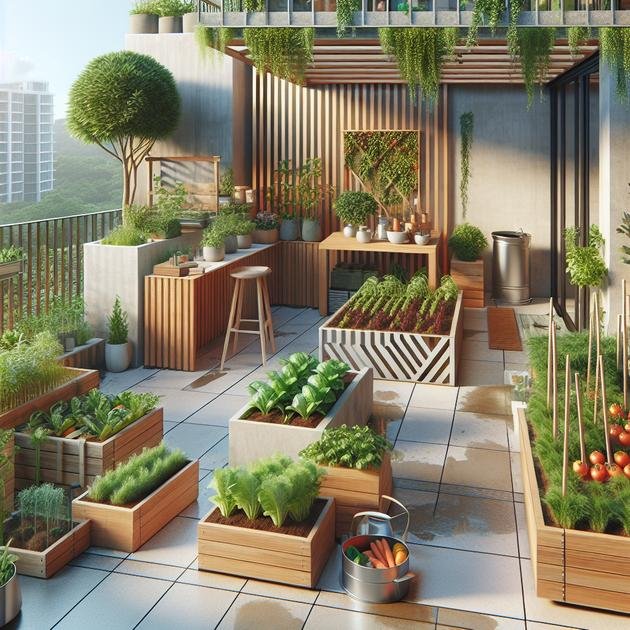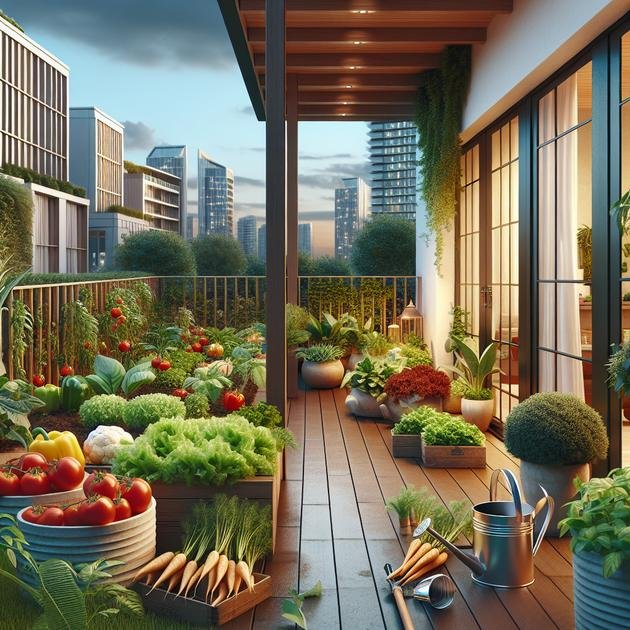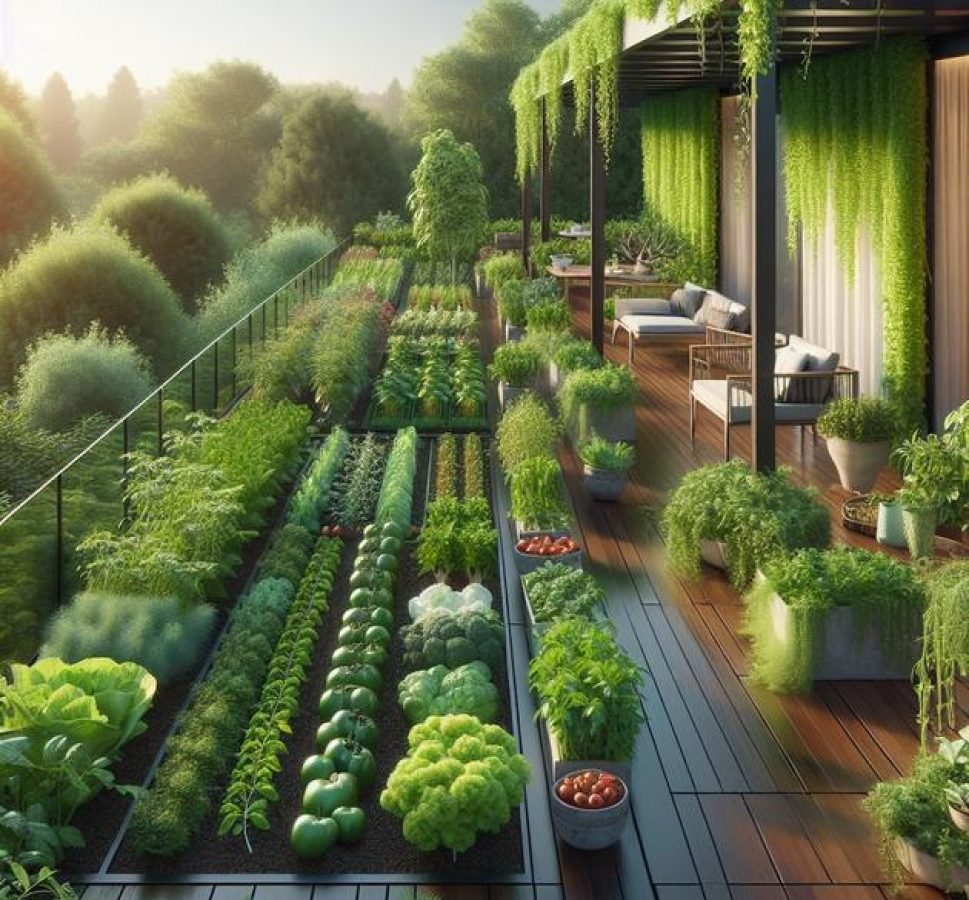A terrace vegetable garden maximizes limited space by using containers, vertical supports, and smart watering, focusing on suitable vegetables and natural pest control to ensure healthy, productive plants in urban environments.
If you’ve ever thought about growing your own fresh food but feel limited by space, a terrace vegetable garden could be the perfect solution. Curious how to start and make the most of it? Let’s dive into some ideas that might just change your approach to gardening.
Choosing the right vegetables for your terrace garden
Choosing the right vegetables for your terrace vegetable garden is key to a successful harvest. Start by selecting plants that thrive in containers and have a relatively short growing season. Leafy greens like lettuce, spinach, and kale are excellent choices because they grow quickly and don’t require deep soil.
Tomatoes, peppers, and herbs such as basil and parsley also do well in pots and can add flavor to your kitchen. Consider dwarf or bush varieties that take up less space. Root vegetables like radishes and carrots can grow in deeper containers, but make sure the soil is loose and well-drained.
Factors to Consider
Make sure the vegetables you choose match your terrace’s sunlight exposure. Most veggies need at least 6 hours of direct sunlight daily. If your terrace is shady, opt for leafy greens and herbs that tolerate less sun. Additionally, think about how much time you can commit to maintenance since some plants require more care than others.
Planning a mix of vegetables with staggered harvest times can keep your terrace garden productive throughout the growing season. Start small to get familiar, then expand your variety as you gain confidence.
How to prepare soil and containers
Preparing soil and containers is a crucial step for a thriving terrace vegetable garden. Start by choosing containers with good drainage holes to prevent waterlogging, which can harm plant roots. The size of the containers should match the vegetable’s growth requirements—larger vegetables need deeper pots.
Use high-quality potting mix rather than garden soil since it retains moisture better and provides necessary nutrients. You can enhance the soil by adding organic compost, which improves fertility and structure.
Steps to Prepare Soil and Containers
First, clean your containers to remove any pests or diseases from previous plants. Next, fill containers with the potting mix mixed with compost or organic fertilizer. Avoid overfilling; leave about an inch of space from the top for watering.
Regularly check the moisture by sticking your finger about an inch into the soil — if it feels dry, it’s time to water. Proper soil preparation and container choice help create an ideal environment for your vegetables to grow healthy and strong.
Maximizing sunlight exposure on a terrace
Maximizing sunlight exposure is essential for a healthy terrace vegetable garden. Most vegetables require at least 6 hours of direct sunlight daily to grow well. Identify the sunniest spots on your terrace by observing the sunlight pattern throughout the day.
If your terrace space is limited or shaded, try to position containers where they will receive the most light, such as near south-facing walls or corners that stay bright longer. Using reflective surfaces like mirrors or white walls can help bounce additional light onto your plants.
Strategies to Improve Sunlight Access
Consider using movable containers or plant caddies so you can adjust the plants’ positions as the sun changes with seasons. Raised beds or vertical gardening can help maximize space and sunlight exposure by layering plants and avoiding shading lower-growing vegetables.
Prune any nearby bushes or trees that block sunlight, and avoid placing larger plants in front of smaller ones that need light. Remember, balanced sunlight helps plants produce more fruit and prevents them from becoming leggy or weak.
Smart watering techniques for terrace plants

Watering plants on a terrace requires care to avoid both overwatering and underwatering. Using smart watering techniques helps ensure your vegetables get just the right amount of moisture. Start by checking the soil moisture regularly—stick your finger about an inch into the soil; if it feels dry, it’s time to water.
Early morning watering is ideal because it reduces evaporation and allows plants to absorb water before the heat of the day. Try to water at the base of plants rather than overhead to prevent fungal diseases and wasted water.
Effective Watering Methods
Investing in self-watering pots or drip irrigation systems can make watering easier and more precise, especially for busy gardeners. These systems deliver water slowly and directly to the roots, reducing runoff and keeping leaves dry.
Mulching your pots with organic materials like straw or wood chips can help retain soil moisture and regulate temperature. Remember, consistent watering routines encourage steady plant growth and better yields on your terrace vegetable garden.
Using vertical space effectively
Using vertical space effectively can greatly increase the productivity of your terrace vegetable garden. Vertical gardening allows you to grow more plants in less ground space by stacking or hanging containers upward. This technique is ideal for small terraces where floor space is limited.
Trellises, wall-mounted planters, hanging baskets, and vertical towers are excellent options to create multi-level planting areas. Climbers like beans, peas, and cucumbers thrive on trellises, saving space and improving air circulation.
Benefits and Tips for Vertical Gardening
Vertical gardening not only maximizes space but also makes harvesting easier and reduces pest problems by keeping plants off the ground. Use sturdy supports and secure attachments to avoid accidents from heavy pots or strong winds.
Rotate your plants in vertical containers to ensure even sunlight exposure. Combine decorative plants with vegetables to add visual appeal to your terrace garden. Remember to choose lightweight containers and monitor water needs, as vertical setups may dry out faster.
Natural pest control tips for terrace gardens
Natural pest control is vital for maintaining a healthy terrace vegetable garden without harmful chemicals. Start by encouraging beneficial insects like ladybugs and praying mantises, which prey on common pests. Planting flowers such as marigolds or nasturtiums nearby can attract these helpful insects.
Use homemade sprays made from garlic, neem oil, or soapy water to deter insects without damaging your plants. Apply these treatments early in the morning or late in the evening to protect pollinators.
Preventive Measures
Regularly inspect your plants for signs of pests and remove affected leaves promptly. Crop rotation and planting pest-resistant varieties can reduce infestations. Maintaining cleanliness by removing fallen leaves and debris also helps prevent pests from settling.
Companion planting is another effective strategy—pair vegetables like tomatoes with basil or carrots with onions to naturally repel pests. These simple, natural techniques keep your terrace garden thriving and eco-friendly.
The importance of composting on your terrace
Composting on your terrace is a simple and effective way to enrich your terrace vegetable garden with nutrient-rich soil. It helps recycle kitchen scraps like vegetable peels, coffee grounds, and eggshells into organic matter that improves soil structure and fertility.
Using a small compost bin or worm composting system makes it easy to manage waste in limited space. Compost adds essential nutrients that support healthy plant growth and improve water retention in containers.
How to Start Composting on a Terrace
Place a compost container in a shaded corner of your terrace to avoid odors. Balance green waste (like fruit and vegetable scraps) with brown materials (such as dried leaves or paper) to encourage proper decomposition.
Turn your compost regularly to aerate and speed up the process. Over time, you’ll see dark, crumbly compost ready to mix with your potting soil, boosting the overall health and productivity of your garden.
Incorporating companion planting in small spaces

Incorporating companion planting in small terrace gardens maximizes space while benefiting plant health and productivity. Companion planting involves growing certain plants close together to improve growth, repel pests, or enhance flavors.
Good pairings for terrace gardens include tomatoes with basil, which can improve tomato flavor and repel pests. Planting carrots near onions helps deter carrot flies. Leafy greens like lettuce grow well beside radishes, making efficient use of space.
Benefits and Tips for Companion Planting
Companion planting can reduce the need for chemical pesticides and increase overall yields. Use containers or raised beds to separate incompatible plants and experiment with different combinations to see what works best in your space.
Rotate your companion plants each season to maintain soil health and reduce disease risk. This method not only saves space but also creates a balanced, thriving terrace vegetable garden.
Seasonal planting guide for terrace vegetable gardens
Following a seasonal planting guide ensures your terrace vegetable garden thrives year-round. Different vegetables grow best in specific seasons, so planning your planting schedule is essential to maximize yields.
Cool-season crops like lettuce, spinach, and radishes do well in early spring and fall when temperatures are mild. Warm-season crops such as tomatoes, peppers, and cucumbers prefer the heat of summer.
Tips for Seasonal Planting
Start seeds indoors during late winter for spring transplanting to get a head start. Pay attention to frost dates in your region to avoid planting too early or too late.
Rotate your crops seasonally to prevent soil depletion and reduce pests. Using this guide, you can enjoy fresh vegetables from your terrace garden throughout the year while adapting to your local climate.
DIY trellises and supports for climbing plants
Building DIY trellises and supports is a practical way to promote healthy growth of climbing plants in your terrace vegetable garden. Using materials like bamboo stakes, wooden frames, or repurposed ladders can create strong and attractive structures for plants like beans, peas, and cucumbers.
Start by selecting sturdy, weather-resistant materials that can handle the weight of mature plants. Assemble simple A-frame trellises or vertical poles tied together with twine or wire to provide ample support and airflow.
Tips for Effective Trellis Support
Place trellises in spots that ensure plenty of sunlight and allow easy access for harvesting. Secure the bases firmly to prevent tipping during strong winds.
Encourage climbing plants by gently guiding tendrils to the supports early on. This not only conserves terrace space but also protects plants from soil-borne pests by lifting them off the ground.
Using hydroponics on your terrace
Using hydroponics on your terrace vegetable garden allows for soil-free growing that is ideal for small spaces. This method uses nutrient-rich water solutions to deliver all the essentials plants need to grow, making it faster and cleaner than traditional gardening.
Hydroponic systems can be as simple as a small container with nutrient solution and net pots or more complex setups with pumps and timers. Popular vegetables for hydroponics include lettuce, spinach, herbs, and even tomatoes.
Benefits and Setup Tips
Hydroponics saves space and water, making it perfect for terraces. It also reduces pest problems since there is no soil. To start, choose a compact system that fits your space and ensure it gets adequate light, either natural or from grow lights.
Regularly monitor nutrient levels and water quality to keep plants healthy. With some attention, hydroponics can provide fresh, high-yield vegetables right from your terrace all year round.
Tips for maintaining plant health in windy conditions

Windy conditions on a terrace can stress plants, causing damage and impacting growth. To maintain plant health, it’s important to provide protection against strong winds. Use windbreaks like lattice screens, fences, or tall plants to shield your vegetables from harsh gusts.
Choose sturdy container materials and secure them well to prevent tipping. Group plants together to create a microclimate that reduces wind impact and helps retain moisture.
Additional Care Tips
Regularly check for broken stems or leaves and prune damaged parts to encourage healthy growth. Water plants adequately, as wind tends to dry out soil faster. Consider staking taller plants to provide support against shaking.
By creating a wind-safe environment and attending to plant needs, your terrace garden will thrive even in breezy conditions.
Creative ways to recycle materials for terrace gardening
Recycling materials creatively is a sustainable way to build your terrace vegetable garden while reducing waste. Old wooden crates, pallets, and even plastic bottles can be repurposed into planters, garden beds, or vertical gardens.
Cut plastic bottles in half to create small pots for seedlings or use them as self-watering containers by adding a wick system. Wooden pallets can be mounted on walls to hold multiple pots, saving space and adding charm.
Tips for Safe and Effective Recycling
Make sure any recycled material is clean and free from harmful chemicals. Sand down rough edges of wood and seal containers to prevent water damage. Combining recycled items with fresh soil and healthy plants creates an eco-friendly, beautiful terrace garden.
Upcycling not only saves money but also allows you to customize your garden’s layout, making it uniquely yours while supporting the environment.
Harvesting and storing your terrace-grown vegetables
Harvesting your terrace-grown vegetables at the right time ensures peak flavor and nutrition. Pick vegetables in the morning when temperatures are cooler to maintain freshness. Use clean, sharp tools to avoid damaging plants.
Some vegetables like leafy greens and herbs can be harvested continuously by snipping outer leaves, while others like tomatoes and peppers are best picked when fully ripe.
Storing Your Harvest
Store vegetables properly to extend their shelf life. Keep leafy greens in a damp cloth inside the refrigerator, while root vegetables like carrots do well in cool, dark places. Tomatoes are best stored at room temperature away from direct sunlight.
Preserve excess produce by freezing, pickling, or drying if you have more than you can use immediately. Proper harvesting and storage maximize your terrace garden’s benefits and reduce waste.
Troubleshooting common problems in terrace gardens
Terrace gardens can face common problems like pests, diseases, and nutrient deficiencies. Identifying these issues early helps protect your plants and ensures a healthy garden. Regular inspection is key to catching problems before they spread.
If you notice yellowing leaves, it might indicate a lack of nitrogen or overwatering. Wilting could be caused by underwatering or root damage. Pests such as aphids and spider mites often show visible signs; use natural remedies to control them.
Effective Troubleshooting Tips
Remove affected leaves or plants promptly to prevent disease spread. Test soil pH and nutrient levels regularly to maintain the right balance. Rotate crops and maintain cleanliness to reduce pest buildup and soil fatigue.
Using organic fertilizers and companion planting can boost plant resilience. Keeping a watering schedule and avoiding waterlogging further supports plant health in your terrace garden.
Bringing It All Together for Your Terrace Vegetable Garden
Creating and maintaining a thriving terrace vegetable garden is easier when you understand how to tackle common problems, care for your plants, and organize your space efficiently. Regular checks and natural methods help keep your plants healthy and productive.
By staying attentive to pests, diseases, and soil health, and by practicing good watering and planting habits, you can enjoy fresh vegetables all year round. With some patience and creativity, your terrace garden can become both beautiful and fruitful.
Remember, every small step counts toward growing a successful garden that brings you joy and fresh produce right at home.





